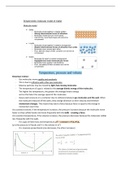Summary
GCSE/IGCSE Physics Summary Notes (A* Student) - Unit 3 Matter for CIE/ CAIE, AQA, Edexcel and OCR
- Course
- Institution
General physics, Thermal physics, Properties of waves, including light and sound, Electricity and magnetism, Atomic physics
[Show more]



